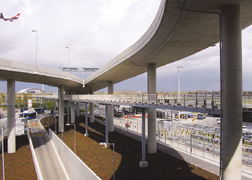
Arup Group Airport transit system will make debut in London.
|
The elevated track of London Heathrow Airport’s new personal rapid-transit (PRT) system is on the verge of completion. PRT advocates say it is the world’s first true PRT system. The 1.1-km line will carry four-person automated vehicles between the new Terminal 5 and two parking-lot stations.
Passengers will punch in a destination at the station, and their vehicles will arrive non-stop. In the future, the system will use smart cards for payment and passenger profiles.
Airport owner BAA PLC chose the pioneering system because “we found it difficult to solve the problems we face with traditional means,” says PRT manager David Holdcroft.
With its lightweight track, the system suits cramped airports, says Holdcroft. “You can in sert PRT...without very much disruption [or] displacing what’s there.” BAA bid the project internationally three years ago. It signed a delivery contract with Advanced Transport Systems Ltd., Bristol, last October.
PRT was technically established but needed BAA’s input in catering to Heathrow’s needs, says Holdcroft. BAA bought 25% of ATS for $14 million “to share in the success.”
ATS founder Martin Lowson started developing PRT in 1995. His aim was “to provide something on demand, without stops.” Rival systems in the U.S., Sweden and elsewhere are still in developmental phases, he says.
BAA’s project cost is about $50 million. Track construction by ATS’s subcontractor Laing O’Rourke Group, Dart ford, accounts for over half that cost.
To ease construction, ATS’s structural engineer Arup Group Ltd., Bristol, designed the elevated steelwork track to be modular and lightweight. “It’s no heavier than a pedestrian footbridge,” says director Tony Kerr.
Because vehicles are guided by track-side lasers, tight fabrication tolerances eliminated structural irregularities. “We don’t want...a fairground-ride experience,” says Kerr.
ATS now has three vehicles undergoing en durance trials. Lowson expects vehicle delivery from a U.K. supplier to start this summer, followed by commercial operations a year later.
“We need to evaluate the scheme for a year,” says BAA’s Holdcroft. Then, BAA has “the intent” to extend the system to the airport’s central zone, serving the northern perimeter.
Even before Heathrow’s first vehicle takes off, “we’ve had a lot of interest from airports around the world,” says Holdcroft. At Passenger Terminal World, held in Amsterdam this April, a whole day of sessions was dedicated to discussing the PRT project. Presenters there noted that the battery-powered vehicles give off no emissions and could eliminate 5 million bus trips a year.
 Related Links:
Related Links: 
Post a comment to this article
Report Abusive Comment